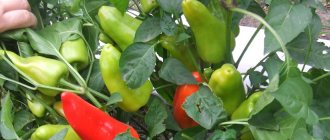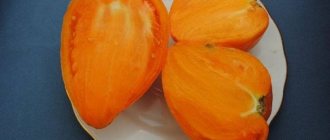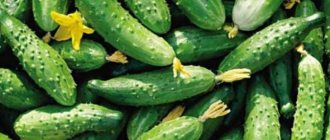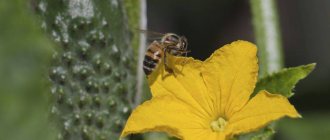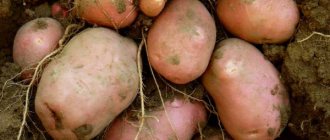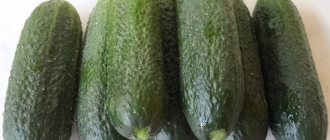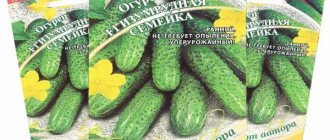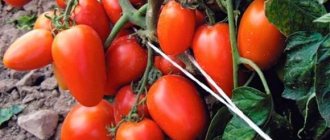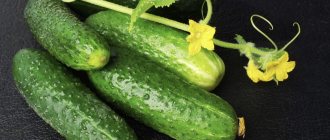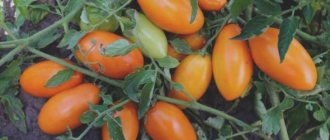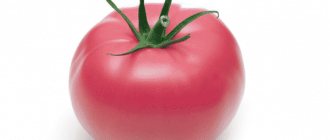Cucumber Serpentine is a new variety bred by breeders. Suitable for gardeners who prefer to grow varietal crops and prepare their own seed. Breeders tried to endow the cucumber with valuable qualities: early ripeness, high yield.
| Landing location | Ripening time | Mode of application | Fruit length | Group | Fruit smoothness | Pollination method |
| Open ground | Early ripening (35-45 days) | Universal | Short (gherkins) - less than 10 cm | Variety | Highly lumpy | Bee pollinated |
Description
Serpentine belongs to the plants of the indeterminate type; its vines grow up to 2 meters in length and require tying to a support. If desired, you can leave them untied, allowing them to weave along the surface of the earth in any direction. But such a horizontal arrangement significantly reduces the access of light and air to the fruits, which can negatively affect their quality and yield as a whole.
You might be interested in
Cucumber Hector F1
Cucumbers of this variety are among the first to ripen. From planting to the appearance of fruits at the stage of technical maturity, an average of 40 days pass. If weather conditions are suitable for early planting, then harvesting can begin in June.
Related article:
Cucumbers on film
Pollination of flowers occurs with the help of wind or insects. If cucumbers are grown in a greenhouse, then this procedure must be carried out artificially. Since male and female flowers grow on the same bush, it is necessary to transfer pollen from the stamens to the pistils with a cotton swab or cotton swab. The process is quite labor-intensive, so Serpentine is grown mainly in open ground.
Pest treatment
Many problems arise for gardeners as a result of the actions of various insect pests. A battle with cucumber “enemies” is mandatory, if, of course, the gardener is interested in the end result. Most often, cucumber is attacked by aphids, spider mites and root-knot nematodes.
In order for the aphids to go away, you can spray the leaves with tobacco infusion or tincture of wood ash with laundry soap. Onion (70-90 g per 10 liters of warm water) and garlic (40-60 g per 10 liters of warm water) infusion will also help remove aphids from cucumbers. After 24 hours it can be used for watering.
Spider mite
You can destroy it by spraying it with a special solution sold in the store. A soap solution can also help solve this problem.
As you know, varieties of cucumbers are divided into salad, pickling and the most popular - universal. These include Serpentine, bred in 1995 at the West Siberian Vegetable Experimental Station of the All-Russian Research Institute of Vegetable Growing. Authorship assigned to L.G. Savinova, N.T. Belonosova, V.G. Vysochinin and A.A. Rybalko. In 1999, the new product was included in the State Register of Breeding Achievements of Russia. Admission was obtained in the following regions: Central, Central Black Earth, Volga-Vyatka, East Siberian, West Siberian. Cucumber is suitable for growing in open ground and under film covers in private farms. Over the years of cultivation, it has gained popularity in Moldova and Ukraine. Not a hybrid.
Main characteristics
The bushes have very good parameters for cucumber crops:
- shoots – strong, climbing, medium-leafy, up to 2 m long;
- leaves are not too large, slightly dissected, with moderate roughness and slight wrinkles on the surface;
- flowering - monoecious type with the same number of staminate and pistillate flowers;
- ovaries - formed in bunches.
The fruits also have excellent characteristics:
- average length – 9.65 cm;
- diameter – 3.8–4 cm;
- weight – 80–120 g;
- shape – oval-elongated;
- the surface is slightly ribbed, coarsely lumpy, covered with black spines;
- the skin of the fruit is bright green, with moderate density, but without hardness;
- the pulp is juicy, with pronounced crunchiness;
- taste – sweetish, without bitterness, with a fresh cucumber aroma.
Related article:
Cucumber Izobilny F1 - description and characteristics of a high-yielding hybrid
The fruits ripen very quickly, so they need to be collected every other day at most to prevent overgrowth. Although overripe specimens do not have a tendency to turn yellow, they are valued less than small young green ones. The harvested crop is well stored and can be stored in a cool place for up to 15 days without changing the structure or losing commercial qualities.
General information
This variety of cucumbers, among other advantages, has a high degree of productivity. Pollination occurs due to bees and bumblebees, that is, naturally. In addition, “Serpentine” has mixed flowering, and it cannot be classified as either a purely “female” or a “male” variety. The bushes are formed moderately, without obvious secondary signs, climbing is above moderate, the shoots are strong and durable. The leaves grow to medium size and have a bright green color.
Bundle ovaries of a cucumber can yield a harvest of 4 to 6 kg from each bush, and this is not the limit.
The fruits have an elongated ovoid shape and have a memorable taste. The fruit pulp is crispy and refreshing. “Serpentine” is absolutely devoid of bitterness and unpleasant aftertaste. The fruit does not turn yellow, the skin is dense with small tubercles on the surface. There is subtle ribbing throughout the entire surface. The color of the cucumber is pale green with barely visible stripes. There is black fluff on the surface of the tubercles. The length of the greens reaches 9-10 cm. The fruit can weigh from 70 to 80 grams.
Productivity
The variety has high yields, but its averages differ slightly depending on the climate of the area. For example, when grown on an industrial scale in the Central Black Earth region, 130–220 c/ha are collected, in the Western Siberian District – 170–350, and in the Omsk region – 375.
See also the article about the Khrustishka F1 cucumber
In garden plots and summer cottages, the yield is measured in smaller units and amounts to 5 kg per bush or up to 20 kg per 1 square meter. m per season. The yield of marketable products is 85–94%.
From planting to harvesting
Like most other varieties, Serpentine cucumbers can be sown immediately when the optimal average daily temperature has been established.
As a rule, the threat of cold weather (especially at night) decreases sharply in early May. The seeds perfectly tolerate temperatures of 10-12 degrees. As for the sowing scheme, it is classic here - 50 by 50 cm. If desired, you can use 70 by 30 cm, but the first option will be more preferable. It is best to plant the seeds at a depth of 3 to 5 cm, but not deeper. As mentioned above, it is allowed to grow cucumbers under a tent or other cover (polyethylene), but it is important to observe the order of planting. “Serpentine” must be mixed with onions, peppers, cabbage or potatoes to give the soil a little rest
In addition, the soil needs loam for active fruiting of plants planted in it. Do not forget about the saturation of the soil with oxygen (so-called aeration). For optimal oxygen content in the soil, you can add sawdust and rotted leaves in advance (before planting), mixing them with the soil. The resulting composition will allow enough oxygen to pass through to make the cucumber feel comfortable.
The description of cucumbers says that they are unpretentious in terms of care, and this is true. In addition, they do not require active watering, only if the soil is thoroughly dry. This sets them apart from most of their fellow hybrids, which require much more watering, literally tying the gardener to the beds for the entire growing season.
Feeding can be done once every 7-10 days. To do this, it is necessary to dilute manure and urea (together or separately).
Since caring for “Serpentine” is not at all burdensome, you can count on a wonderful harvest even in a hot (or vice versa, cold) summer. The fruiting of this cucumber variety is stable and abundant. Crop failures are quite rare. In the harsh Siberian conditions, “Serpentine” feels quite comfortable, without requiring any additional care. Another positive feature of cucumber is long-term storage, which allows you to transport greens over long distances without fear of loss of presentation. Of course, this quality, coupled with resistance to frost (at night), has already been appreciated by Siberian summer residents and farmers who grow this wonderful variety on their plots.
Many gardeners note not only high yields, but also significant convenience in caring for the plant. Many of those who left their opinion (along with a photo of the grown crop) consider “Serpentine” to be the best option for growing in the conditions of Siberia and central Russia.
Area of application of fruits
Greens of the Serpentine variety are universal in use. They perfectly retain the structure of the pulp during short heat treatment, so they are suitable for pickling and preparing various salads for the winter. These cucumbers are also consumed lightly salted, salted and fresh, added to salads, snacks, sandwiches and other dishes.
Related article:
How to increase the yield of cucumbers: 10 useful tips
Cucumber varieties by type of use
When selecting seeds, it is important to remember that all varieties and hybrids differ from each other and in the direction of use. Salad cucumbers have a fairly thick skin, so they do not behave well in pickling, although they are suitable for the lightly salted version
| Name of variety/hybrid | Salad type | Canning | Universal |
| Abbad | |||
| Vanguard | |||
| Advance F1 | |||
| Alligator F1 | |||
| April F1 | |||
| Balcony F1 | |||
| Minion F1 | |||
| Borisych F1 | |||
| Barrel F1 | |||
| True friends F1 | |||
| Funny guys F1 | |||
| Vitan | |||
| Vladivostok-sky 155 | |||
| Aquarius | |||
| Waterfall | |||
| Volgodonskaya 231 | |||
| Voronezh | |||
| East | |||
| Vyaznikovsky 37 | |||
| Vyazovets | |||
| Geisha F1 | |||
| Hercules F1 | |||
| Hotel F1 | |||
| Far Eastern 27 | |||
| F1 debut | |||
| Dean | |||
| Friendly family F1 | |||
| Unity | |||
| Snack bar | |||
| Pickling | |||
| Zozulya F1 | |||
| Zyatek F1 | |||
| Abundant F1 | |||
| Elegant | |||
| Katyusha F1 | |||
| Kashmir F1 | |||
| Quartet F1 | |||
| Competitor | |||
| Shorty | |||
| Krakow F1 | |||
| Fastener F1 | |||
| Magician | |||
| Courage F1 | |||
| Bush | |||
| F1 leader | |||
| Lilliputian F1 | |||
| Lotus | |||
| Lohengrin F1 | |||
| Lukoshko F1 | |||
| Baby | |||
| Baby | |||
| Boy with Thumb F1 | |||
| Mommy's favorite F1 | |||
| Manila F1 | |||
| Marawa F1 | |||
| Masha F1 | |||
| Miser F1 | |||
| Micron | |||
| Monastic | |||
| Moscow dude F1 | |||
| Hope | |||
| Nezhinsky | |||
| Odessa F1 | |||
| Pavlik F1 | |||
| Robin Hood F1 | |||
| Russian style F1 | |||
| Northern Lights F1 | |||
| North Pole F1 | |||
| Seryozha F1 | |||
| Siberian F1 | |||
| Solar | |||
| Madam | |||
| Toropyzhka F1 | |||
| Tristan F1 | |||
| Faris | |||
| Phoenix | |||
| Phillipok F1 | |||
| Frigate F1 | |||
| Swag | |||
| Crispy Alligator F1 | |||
| Miracle Khrustik F1 | |||
| Shaolin F1 | |||
| Espagnolette F1 | |||
| Dapper F1 | |||
| Nutcracker F1 | |||
| HWY 406 F1 | |||
| F1 crew | |||
| Eliza F1 | |||
| Erica F1 | |||
| Eskimo F1 | |||
| Effect F1 | |||
| Juventa F1 | |||
| Julian F1 | |||
| Yurik F1 | |||
| Fair F1 |
Tags: cucumber, main, feature, serpentine, characteristic About the author: admin4ik
Diseases and pests
The immunity of the variety is average. Under favorable climatic conditions and proper agricultural technology, he rarely gets sick. But any violations increase the risk of being affected by the main infections and pests of a given crop.
The most common diseases encountered in Serpentine are:
- Powdery mildew . The green parts of the plants become covered with whitish spots that spread quickly. The risk of injury increases significantly with high humidity and large temperature changes. Infected leaves and shoots are removed, and watering and feeding of the plants is stopped. For treatment, spray (once a week until signs disappear) with a solution of copper sulfate (15–20 g per 5 l), soda (30–40 g per 5 l) with soap shavings, potassium permanganate (2–3 g per 5 l ) or treated with Topaz fungicide according to the instructions.
- Ascochytasis . It appears on the leaves in the form of small light spots that quickly grow and acquire a brown tint. Then the shoots and fruits are affected. Irrigation with warm water and pre-sowing seed disinfection help prevent infection. To destroy the causative fungus, use a solution with the addition of copper sulfate and chalk in equal quantities.
Related article:
Growing strong cucumber seedlings
To treat these and any other fungal infections at more serious stages, fungicidal preparations are used (except during the fruiting period). Among the viral diseases in cucumbers, root rot occurs, which affects the root system, after which the entire plant dies. Such diseases cannot be treated. For prevention, you should follow the rules of watering, remove weeds in a timely manner and prevent the plantings from becoming dense.
How to save cucumbers from powdery mildew
Pests of cucumber include aphids, root-knot nematodes and spider mites. Against aphids, the bushes are sprayed with a soap solution with the addition of crushed ash, as well as infusions of tobacco, onion peels or garlic. The root-knot nematode is removed from the site along with the top layer of soil 50 cm high, and if this method is not available, it is spilled with boiling water or a saturated solution of potassium permanganate. Spider mites and other insect pests are destroyed using the specified ash-soap solution or insecticides.
Related article:
7 fatal mistakes when growing cucumbers that every gardener should avoid
Diseases and parasites
According to the description, Christina is almost not afraid of common diseases and bacteria
However, this cucumber attracts the attention of some dangerous parasites - prevention of damage to the bushes of the variety is aimed mainly at combating them
Medvedka
This is a fairly large insect that eats up the stems and roots of the variety and spreads in areas with an excess of organic matter. A good way to prevent Christina f1 from the occurrence of the pest are strong-smelling decoctions: garlic, marigolds, onion peels, etc. If there are a lot of mole crickets in the beds, only chemicals will save the cucumber: Zolon, Medvetox, etc.
Whitefly
The whitish butterfly larvae settle on the underside of Christina's leaves and eat them, drying out the bushes. In the early stages of the parasite's spread, the cucumber is protected by spraying with a weak soap solution. If the butterfly has already taken a fancy to the plantings, you will have to treat them with such preparations as Bud, Iskra, Tanrek, etc.
Root nematode
This microscopic pest attacks the roots of Christina f1. You can notice it by swellings and nodules on the root system. It is almost pointless to fight the emerging parasite. The best prevention against nematodes is to dig up the cucumber area to 50 cm in the fall. Affected bushes of the variety must be removed and burned, and the places where they grew should be disinfected with a formaldehyde solution.
Advantages and disadvantages
Serpentine has many advantages, including:
- rapid ripening in the earliest stages;
- high productivity;
- relative resistance to infections and pests;
- low maintenance requirements;
- possibility of growing in different climates;
- universal application;
- good shelf life, possibility of long-term transportation;
- high germination of seeds when collected independently;
- excellent taste and other consumer characteristics.
The only disadvantage of the variety is the presence of many thorns on the surface of the fruit. Because of this, they should only be collected with gloves and washed with a brush to remove thorns before use.
Reviews
Alexey Eduardovich, 50 years old, Kirov region
I liked the hybrid variety Serpentine because of its delicate, crunchy taste. Particularly easy to care for. The only drawback is low immunity to powdery mildew. I have never encountered such a disease before. He fought powdery mildew with the drug Hom. The disease progressed greatly, so folk remedies were not effective. Now, taught by bitter experience, I carry out preventive spraying with a solution based on a regular bottle of iodine (10 ml). I dissolve the container with iodine in 10 liters of water and process the entire green mass.
Aelita Stepanovna, 45 years old, Vladimir region
I plant Serpentine cucumbers year after year. Greens are liked for their taste, both canned and fresh. There were no problems with growing. The germination of seed material is good. Plants develop quickly. I usually plant cucumbers in early May. I start harvesting on the 15th of June.
Planting and care
Serpentine seeds can be sown directly into the garden bed, but it is very important to observe the correct timing. Sowing is carried out after the onset of stable warmth and the passing of the threat of night frosts. At this point, the soil should warm up to +10°C...+12°C, which is usually typical for the second half of May or the first ten days of June, depending on the region.
Related article:
The best varieties of cucumbers for open ground
If planting time is running out and the soil has not yet warmed up sufficiently, then cover the bed with black film for several days. It will attract the sun's rays and provide increased heating of the surface.
In regions with a cool climate, the seedling planting method is used. In this case, the seeds are sown in containers in the second half of April - early May, so that by the specified date of planting in the ground (late May - early June) the seedlings are completely ready and do not outgrow. This method allows you to get an earlier harvest, but requires special care when handling cucumber seedlings, since the seedlings are very fragile and are easily damaged by the slightest impact, and also do not tolerate replanting well. To minimize such problems, they are planted exclusively in individual containers, ideally in peat cups or washers (tablets), from which the sprouts do not need to be removed.
The planting area should be well lit and protected from strong winds or drafts. When choosing it, it is necessary to take into account crop rotation so that cucumbers do not grow repeatedly in one place. The best predecessors are considered to be nightshades and legumes, onions, garlic, cabbage, and green manure. The soil in the garden should be loamy with neutral or weak acidity. If necessary, it is deoxidized with dolomite flour.
Related article:
Everything you need to know about cucumber crops
The bed preparation is carried out in the fall:
- the area cleared of weeds and plant debris is dug up with a bayonet;
- When digging, complex fertilizers are applied (per 1 sq. m - a bucket of humus and 200 g of wood ash).
In the spring, another set of events is held:
- the soil is loosened or dug up and disinfected with a solution of potassium permanganate;
- form planting furrows;
- a small layer of humus is placed on the bottom, then a layer of peat;
- cover with a dark film and leave for a week, providing increased heating;
- then the seeds are sown in these furrows.
Pre-sowing seed treatment should include:
- disinfection by soaking for 1–2 hours in a solution of potassium permanganate;
- germination between two layers of damp cloth, which are placed in a bag to retain moisture.
Seeds treated in this way are sown in the ground or for seedlings. In any case, planting in the garden bed is carried out according to the 50x50 cm pattern.
Related article:
How to increase the yield of cucumbers: 10 useful tips
Bee-pollinated hybrids
Bee-pollinated hybrids are intended for open ground
First of all, they are suitable for growing in open ground, but they also develop in greenhouses. Recently, these varieties are not as popular as before, but many still grow them.
The best varieties of bunched cucumbers for open ground include those that show high yields and disease resistance.
Babies on a branch
Cucumber Babies on branch F1
Babies on a branch
An early ripening hybrid variety, fruiting begins at 43 days. Refers to medium-sized and medium-branched plants with a female type of flowering. Recommended for development in open ground using temporary cover in the form of film.
The fruit is cylindrical, short, weighing up to 100 g, size - 8-11 cm. When ripe, it has an excellent taste, is not bitter and does not contain voids. It is considered universal - suitable for pickles and for preparing fresh salads.
Siberian Express
Cucumber Siberian Express F1
Siberian Express
The variety is an early ripening variety, since fruit formation begins 42 days after germination. The hybrid is grown in open ground and under film. It is a plant with medium climbing habit, and if part of the side shoots is removed, up to 11 fruits are formed in the axils of the main stem.
Cucumbers are of a traditional color with tubercles, up to 12 cm in size, each cucumber weighs up to 120 g. The taste is excellent, without any signs of bitterness. Suitable for pickling and salads. Productivity in greenhouse conditions reaches 15 kg.
King of the bed
Cucumber King of the bed F1
King of the bed
The plant is powerful, has an average degree of branching. Can be grown in open ground with temporary film cover. The taste is without bitterness, suitable for canning and salads.
The fruit is dark green in color with small stripes, up to 11 cm long. Up to 5 fruits are tied in each node. The yield is average - about 6 kg of cucumbers per 1 sq. m. Harvesting is comfortable.
It is better to plant seedlings, but often the seeds are planted directly in open ground. The hybrid is unpretentious and resistant to weather changes.
Hokus
Cucumber Hokus
Hokus
The hybrid has an average ripening period. Produced in Finland, suitable for regions with unstable climates.
It is distinguished by stable yield and gradual ripening of fruits. It can be grown by seedlings and by planting seeds in open ground, especially in warm regions. The size of ripe greens reaches 15 cm.
Minion
Cucumber Darling F1
Minion
Fruiting begins on days 45-47 from the moment the first shoots appear; it can be classified as a mid-early variety. The plant is vigorous with abundant foliage, medium branching. It can develop as a whole garland in open ground and in a greenhouse.
Greens are oval-shaped with small black spines. The pulp is quite juicy. The weight of one cucumber is 80 g, the size is up to 10 cm. They produce from 1 sq. m to 16 kg.
The cucumber is tasty, devoid of bitterness, and suitable for preservation.
Carrots: description of the 28 best varieties, characteristics (Photo & Video) | +Reviews
Care after landing
Further care should include the following activities:
- watering - immediately after planting every other day, after rooting of seedlings - once a week, with the beginning of fruiting - twice a week;
- loosening - immediately after watering or rain, to prevent the formation of an earthen crust that impairs air access to the roots;
- tying lashes to trellises pre-installed between rows;
- pinching the main stem after 8 leaves appear on it, which will ensure the regrowth of side shoots;
- fertilizing - adding organic matter 4 times per season (bird droppings diluted in water in a ratio of 25:1 or cow manure - 10:1), as well as potassium, phosphorus and nitrogen additives.
It is also advisable to hill up the bushes, raking wet soil under them while loosening. On both sides of the row it is necessary to form an earthen bank about 7 cm high.
Useful to read: When and how to plant cucumbers?
With such simple care, the Serpentine cucumber will develop well and give the highest possible yields. And the fruits themselves will be juicy, crispy and very tasty.
Related article:
Growing strong cucumber seedlings
Hybrid breeding methods
If a gardener wants to get a harvest by directly sowing seeds in the ground, it is recommended to first treat them with a disinfecting solution (potassium permanganate). The seeds should remain in it for up to 7 hours. The site is being prepared in the fall. They dig it up and add compost to the soil. It is recommended to choose places where tomatoes, lettuce, peppers or cabbage previously grew.
When planting seeds directly, the soil should be warmed to 17-18 °C. It is advisable to increase the height of the bed by 200 mm. Experts recommend digging it up and then covering it with film for 14 days so that the soil warms up well. Furrows up to 30 mm deep are made in the beds. Seeds are placed in them along with manure, and then sprinkled with earth. The area is watered generously with warm water.
If the gardener decides to use the seedling method for propagating the hybrid, then the disinfected seeds are placed in separate boxes. The seed sowing depth ranges from 15 to 20 mm. After about 6-7 days, the first shoots appear. They are fed with manure and watered with warm water once every 4 days. After each plant has 3-4 leaves, they can be transplanted to a permanent place. The format for planting bushes is 0.5 X 0.5 or 0.7 X 0.3 m. If cold weather is expected, it is recommended to cover the young seedlings with film or warm material.
